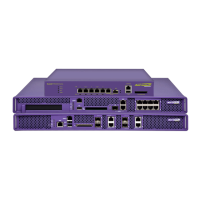Summit WM3000 Series Controller System Reference Guide 197
4 Select a radio and click the Edit button (at the bottom of the screen) to modify its properties. For
more information, see “Editing WMM Settings” on page 197.
Editing WMM Settings
Use the Edit screen to modify a WMM profile's properties (AIFSN, Tx op, Cw Min and CW Max).
Modifying these properties may be necessary as Access Categories are changed and transmit intervals
need to be adjusted to compensate for larger data packets and contention windows. Use “Configuring
WMM” on page 196 to configure downstream traffic parameters. WLAN WMM configuration affects
your upstream traffic parameters.
To edit existing WMM Settings:
1 Select Network > Access Point Radios from the main menu tree.
2 Click the WMM tab.
3 Select a radio from the table and click the Edit button to launch a screen displaying the WMM
configuration for that radio.
4 Enter a number between 0 and 15 for the AIFSN value for the selected radio.
The AIFSN value is the current Arbitrary Inter-frame Space Number. Higher-priority traffic
categories should have lower AIFSNs than lower-priority traffic categories. This will causes lower-
priority traffic to wait longer before trying to access the medium.
5 Enter a number between 0 and 65535 for the Tran smit O ps value.
The Transmit Ops value is the maximum duration a device can transmit after obtaining a transmit
opportunity. For higher-priority traffic categories, this value should be set higher.
6 Enter a value between 0 and 15 for the Extended Contention Window minimum (ECW Min) value.
The ECW Min is combined with the ECW Max to make the Contention Window. From this range, a
random number is selected for the back off mechanism. Lower values are used for higher priority
(video or voice) traffic.
7 Enter a value between 0 and 15 for the Extended Contention Window maximum (ECW Max) value.

